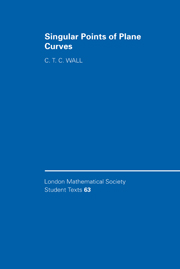Book contents
- Frontmatter
- Contents
- Preface
- 1 Preliminaries
- 2 Puiseux' Theorem
- 3 Resolutions
- 4 Contact of two branches
- 5 Topology of the singularity link
- 6 The Milnor fibration
- 7 Projective curves and their duals
- 8 Combinatorics on a resolution tree
- 9 Decomposition of the link complement and the Milnor fibre
- 10 The monodromy and the Seifert form
- 11 Ideals and clusters
- References
- Index
7 - Projective curves and their duals
Published online by Cambridge University Press: 04 December 2009
- Frontmatter
- Contents
- Preface
- 1 Preliminaries
- 2 Puiseux' Theorem
- 3 Resolutions
- 4 Contact of two branches
- 5 Topology of the singularity link
- 6 The Milnor fibration
- 7 Projective curves and their duals
- 8 Combinatorics on a resolution tree
- 9 Decomposition of the link complement and the Milnor fibre
- 10 The monodromy and the Seifert form
- 11 Ideals and clusters
- References
- Index
Summary
For curves in the projective plane, the most basic invariant is the degree of the defining equation. This gives a qualitative bound for the possible complexities of the curve, and also of its singularities. We will see that this may be turned into precise quantitative bounds.
First, however, we discuss two classical topics. The first is a formula for the genus of a curve in terms of its degree and its singularities. The second is a corresponding formula for its class: the number of tangents to the curve from a generic point. This can be reinterpreted. The tangents to a curve are lines in the plane, which can also be interpreted as points in a dual plane. The locus of these points, or rather its closure, is the dual curve, and the formulae yield relations between the original curve and its dual. The oldest version of these formulae consists of the celebrated Plücker equations.
Our proofs of these results use the technique involving the Euler characteristic which we developed in Theorems 6.4.1 and 6.4.2. A further refinement of this technique consists of the calculus of so-called constructible functions. We describe this, and give a further application, to Klein's formula concerning the singularities of a curve in the real projective plane.
These formulae do not exhaust the relations between the singularities of a curve and those of its dual, and we give a full discussion of the relation between the two.
We conclude with a survey of some of the known results concerning the possible configurations of singularities of curves of a given degree.
- Type
- Chapter
- Information
- Singular Points of Plane Curves , pp. 156 - 186Publisher: Cambridge University PressPrint publication year: 2004



